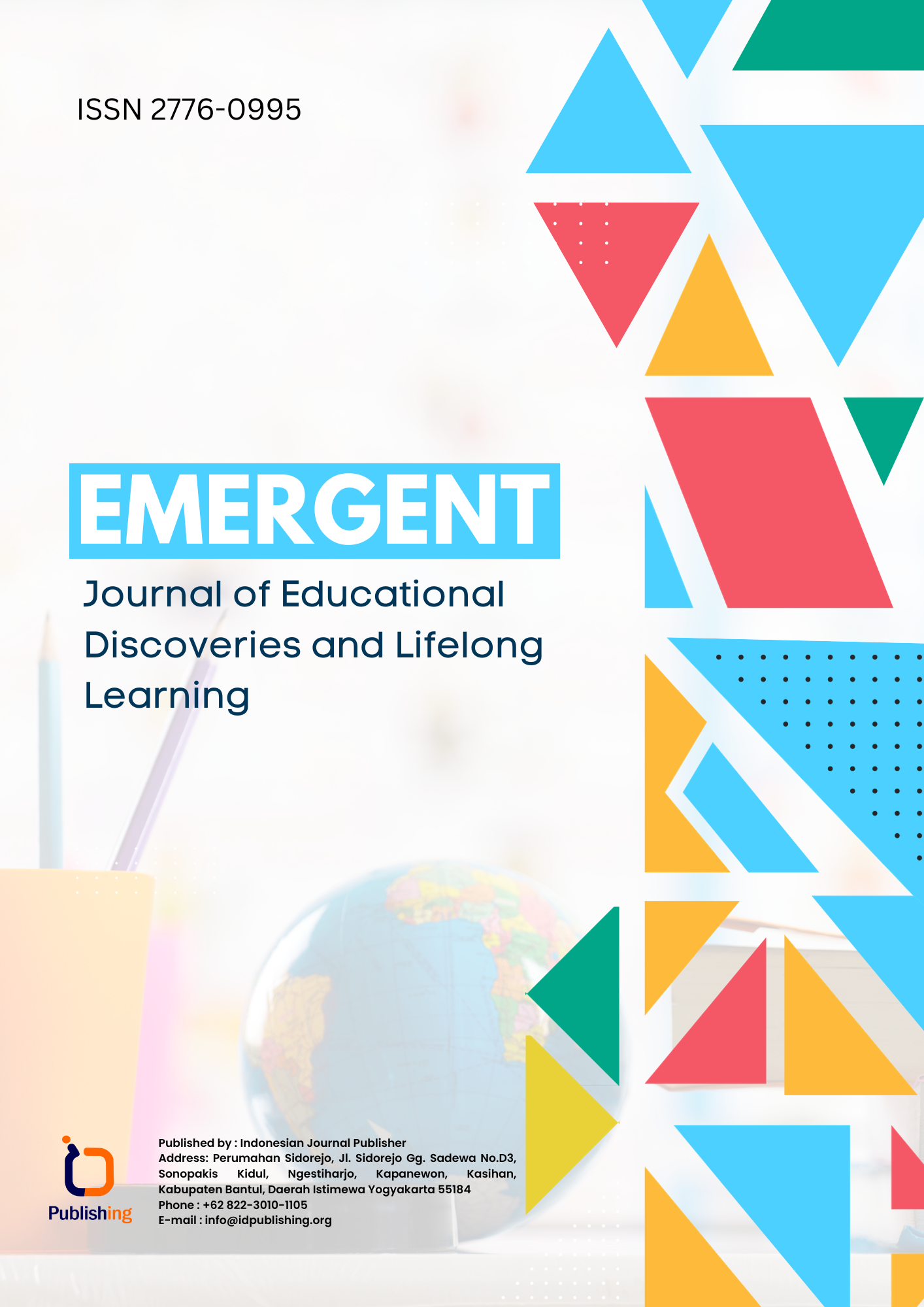The Peculiarities Of Neologizms In Language And Speech
DOI:
https://doi.org/10.47134/emergent.v3i4.52Keywords:
Neologisms, Language Evolution, Ecolinguistics, Sociolinguistics, Language and Culture, Technological ChangeAbstract
Language is a dynamic, evolving process that reflects the ever-changing realities faced by its speakers. One of the key factors driving this linguistic evolution is the creation of neologisms—new words or expressions that emerge to fill gaps in language or express new concepts, often as a response to technological advancements, cultural shifts, and globalization. Neologisms not only enrich the vocabulary but also offer a rich point of analysis in linguistics, shedding light on societal and cultural contexts. They are formed through various processes such as borrowing, compounding, blending, and acronym creation, all of which reflect the interaction between linguistic mechanisms and the cultural environment. This paper explores the formation and implications of neologisms from both linguistic and cultural perspectives, with a particular focus on ecolinguistics and sociolinguistics. Historical examples, such as the Industrial Revolution and the Digital Era, illustrate the deep connection between language and social change. By examining neologisms, this study seeks to illuminate the role of language in adapting to societal transformations and how it serves as both a mirror and a driver of cultural evolution.
References
Leonidovich, S. N., & Vladimirovna, R. I. (2015). 'The Problem of Studying Neologisms and Their Influence on the Ecology of Language'.
Zeidan, A. (2024, August 31). 'Neologism'. Encyclopedia Britannica.
Ismoilova, K. R., Shamsiddinova, G. Z., Maxsudova, N. A., & Turg'unova, M. Z. (2023). 'Neologism in English Language and Its Influence on Linguistics'.
McDonald, L. (2005). The meaning of “e-”: Neologisms as markers of culture and technology. ETopia. https://doi.org/10.25071/1718-4657.36746 DOI: https://doi.org/10.25071/1718-4657.36746
Courtney, J. (2009). The development of the English language following the Industrial Revolution. 'The Victorian Web'.
Sabohat Sharipova. (2024). USAGE OF NEOLOGISMS IN MEDIA DISCOURSE. The American Journal of Social Science and Education Innovations, 6(09), 84–87. https://doi.org/10.37547/tajssei/Volume06Issue09-09 DOI: https://doi.org/10.37547/tajssei/Volume06Issue09-09
Sharipova, S. (2024). Lexical-Semantic Classification of Neologisms in Media Discourse. Pubmedia Jurnal Pendidikan Bahasa Inggris, 2(1), 7-7. DOI: https://doi.org/10.47134/jpbi.v2i1.866
Butnaru, D. (2024). The presence of religious deonyms in the vocabulary of the Romanian language. Onomastica desde America Latina, 5(1), ISSN 2675-2719, https://doi.org/10.48075/odal.v5i1.33073 DOI: https://doi.org/10.48075/odal.v5i1.33073
Valdés-León, G. (2024). Beauty is youth: neologisms in cosmetic product advertising. European Public and Social Innovation Review, 9, ISSN 2529-9824, https://doi.org/10.31637/epsir-2024-1239 DOI: https://doi.org/10.31637/epsir-2024-1239
Raet, M. (2024). A LEXICOLOGICAL PERSPECTIVE ON THE PANDEMIC: THE CASE STUDY OF ESTONIA. Eesti ja Soome-Ugri Keeleteaduse Ajakiri, 15(2), 75-103, ISSN 1736-8987, https://doi.org/10.12697/JEFUL.2024.15.2.04 DOI: https://doi.org/10.12697/jeful.2024.15.2.04
Varchol, M. (2024). Migration of the Term “Neologism” between two Scientific Disciplines. Neologism in Linguistics and Medicine. Etudes Romanes de Brno, 45(2), 125-136, ISSN 1803-7399, https://doi.org/10.5817/ERB2024-2-10 DOI: https://doi.org/10.5817/ERB2024-2-10
Romanov, D.A. (2024). A. N. Radishchev as an "archaist and innovator": linguopoetic and linguostylistic features of the great book (to the 275th anniversary of the birth). Russian Language at School, 85(4), 47-60, ISSN 0131-6141, https://doi.org/10.30515/0131-6141-2024-85-4-47-60 DOI: https://doi.org/10.30515/0131-6141-2024-85-4-47-60
Ponsatímurlà, O. (2024). Is suïcidar-se a reflexive verb or an essentially pronominal verb?. Estudis Romanics, 46, 221-238, ISSN 0211-8572, https://doi.org/10.2436/20.2500.01.385
Kananaj, A. (2024). EXPLORING THE LINGUISTIC LANDSCAPE OF A GLOBAL PANDEMIC: COVID-19 NEOLOGISMS. Revista de Gestao Social e Ambiental, 18(8), ISSN 1981-982X, https://doi.org/10.24857/rgsa.v18n8-003 DOI: https://doi.org/10.24857/rgsa.v18n8-003
Aliyeva, G.B. (2024). On the Use of English Morphological Neologisms as Linguistic Reflection of War: Translation Aspects. World Journal of English Language, 14(1), 170-177, ISSN 1925-0703, https://doi.org/10.5430/wjel.v14n1p170 DOI: https://doi.org/10.5430/wjel.v14n1p170
Cañete-González, P. (2023). Emerging acts of violence: neologisms of crime. Lengua y Sociedad, 22(1), 421-447, ISSN 1729-9721, https://doi.org/10.15381/lengsoc.v22i1.23959 DOI: https://doi.org/10.15381/lengsoc.v22i1.23959
Pak, A. (2023). The Formalized Semantics of Neologisms-Slangisms in the Context of the English Translation of A Military Narrative. World Journal of English Language, 13(6), 537-543, ISSN 1925-0703, https://doi.org/10.5430/wjel.v13n6p537 DOI: https://doi.org/10.5430/wjel.v13n6p537
Nadal, G. Clavería (2023). Neologism and Dictionary in Language Columns: From the 19th Century to the 20th Century. RILCE. Revista de Filologia Hispanica, 39(3), 1029-1055, ISSN 0213-2370, https://doi.org/10.15581/008.39.3.1029-55 DOI: https://doi.org/10.15581/008.39.3.1029-55
Xiang, X. (2023). A Brief History of the Chinese Language V: Middle Chinese Lexicon 1. A Brief History of the Chinese Language V: Middle Chinese Lexicon 1, 1-178, https://doi.org/10.4324/9781003365563 DOI: https://doi.org/10.4324/9781003365563-1
Ahmedova, S.F. (2023). DIPLOMATIC LANGUAGE EVOLUTION IN THE TEXTS OF INTERNATIONAL AGREEMENTS (based on Karabakh conflict settlement documents). Visnyk Universitetu Imeni Alfreda Nobelya. Seriya: Filologichni Nauki, 1(25), 144-165, ISSN 2523-4463, https://doi.org/10.32342/2523-4463-2023-1-25-11 DOI: https://doi.org/10.32342/2523-4463-2023-1-25-11
Xiang, X. (2023). A Brief History of the Chinese Language VIII: Modern Chinese Lexicon 2. A Brief History of the Chinese Language VIII: Modern Chinese Lexicon 2, 1-174, https://doi.org/10.4324/9781003365594 DOI: https://doi.org/10.4324/9781003365594-1
Gómez, I. Jiménez (2022). Mental Health and Climate Change. The Birth of Eco-Anxiety in the Spanish-Language Press. Tripodos, 52, 13-33, ISSN 1138-3305, https://doi.org/10.51698/tripodos.2022.52p13-33 DOI: https://doi.org/10.51698/tripodos.2022.52p13-33
Sajous, F. (2022). Metalexicographical Investigations with the DiCo Database. International Journal of Lexicography, 35(1), 75-106, ISSN 0950-3846, https://doi.org/10.1093/ijl/ecab017 DOI: https://doi.org/10.1093/ijl/ecab017
Downloads
Published
How to Cite
Issue
Section
License
Copyright (c) 2024 Mahliyo Kukiboyeva, Nasiba Rakhimova

This work is licensed under a Creative Commons Attribution 4.0 International License.





